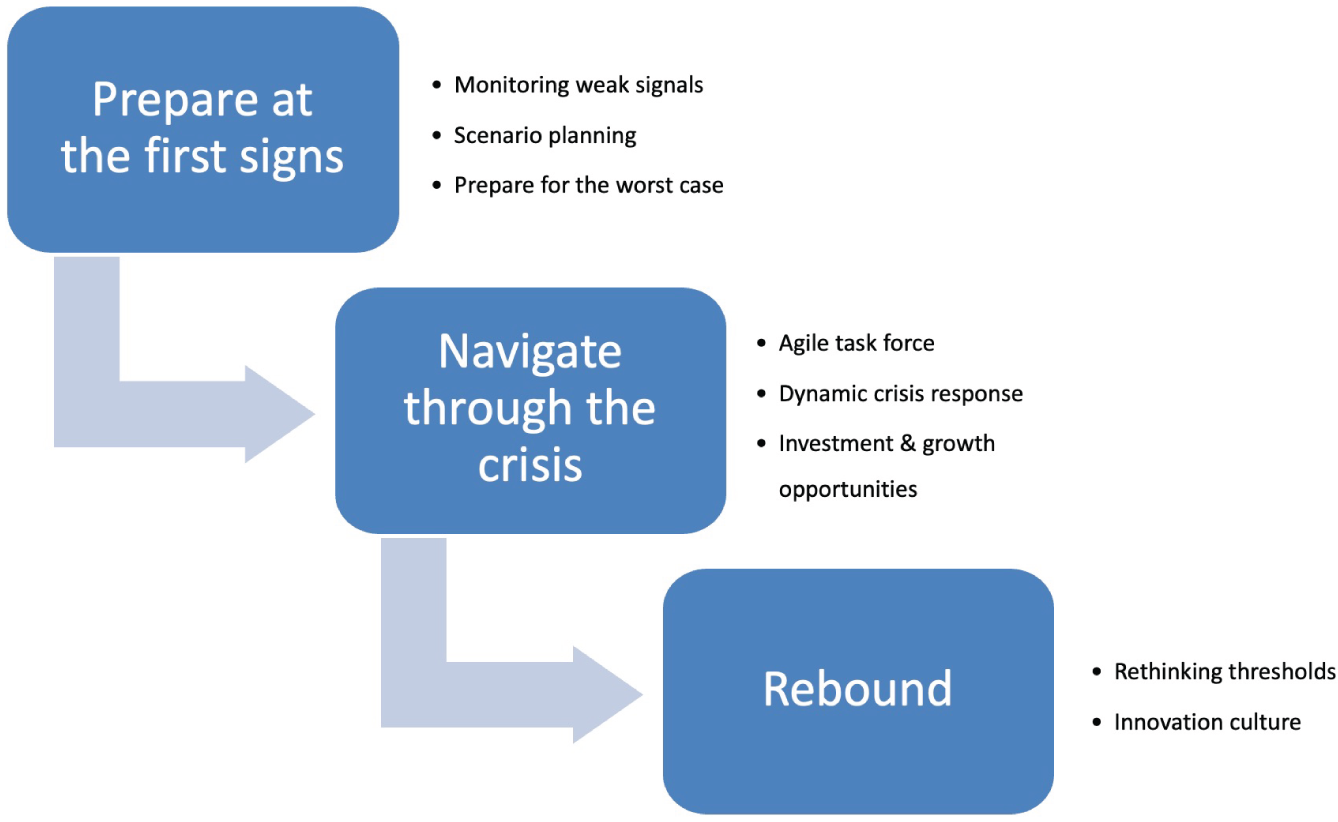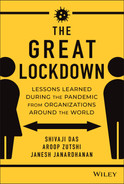CHAPTER 17
Conclusion
By Shivaji Das, Aroop Zutshi, and Janesh Janardhanan
Through the stories shared in these chapters, we have seen the similarities, differences, and variations of organizations’ experiences throughout the pandemic across geographies and industries. How these organizations responded to the crisis provides insight about what can be done at various stages of a rapidly developing disruption. (See Figure 17.1.)

FIGURE 17.1 The ways that various organizations have responded to the pandemic provide a number of insights.
Prepare at the First Signs
Organizations that were able to prepare and react well in the early days of the pandemic generally had better outcomes. Many of the organizations that contributed to this book leveraged their overseas presence to inform their global decision-making. Many, like Terumo, SAP, Julius Baer, and Bangalore International Airport, set up a global task force, war group, or risk assessment team early to collect, analyze, and disseminate information throughout their organization, as well as to suppliers and customers. Besides closely observing government guidelines, these task forces planned ahead, verified organizational preparedness, developed business continuity and contingency plans, and shared best practices.
As more details emerged on the spread of the virus around the world, companies reassessed their ability to manage their business through an extended period of suppressed economic activity. They also studied supplier and customer trends and assessed impacts to business operations. Organizations took a hard look at liquidity positions, staffing, investment plans, and more, and they developed a range of response plans and worst-case scenario plans.
Navigate Through the Crisis
As the pandemic spread around the world, many countries witnessed first, second, and third waves of infection. They went in and out of lockdowns. Under such circumstances, local on-the-ground intelligence that fed into a central task force and enabled coordinated local responses became the key to managing large global organizations.
With a general sense of uncertainty and confusion, many organizations communicated frequently and transparently with employees.
CEOs of organizations that are emerging stronger from the pandemic used this phase not only to manage the disruption but also to identify new opportunities. Globalization Partners, for instance, doubled down on their investments in their core technology platform during the pandemic. In India, IndiGrid made several acquisitions during the pandemic. Hornet added senior engineers and accelerated product rollout during the pandemic.
Rebound
While COVID-19 is far from over, organizations around the world are already adapting to and functioning in “the new normal.” Many are certain that we will never fully go back to the 2019 way of managing operations. Organizations are responding to lockdowns and movement restrictions on extremely short notice. “Digital” and “virtual” for supplier, employee, and customer engagement are deeply embedded in the new normal. Investments in automation for production resilience and logistics are growing.
Reeling from factory shutdowns and port congestion, supply chains are discovering the need to rethink the time-tested “just-in-time” strategy and are now incorporating a “just-in-case” strategy and maintaining higher inventory thresholds closer to consumers. Organizations are also paying more attention to cash and liquidity in the new normal and think differently about investment in physical office spaces and showrooms.
The pandemic has made organizations flex their agility and rapid-response muscles, and many of the hard-learned lessons will better prepare them for future such disruptions.
Perhaps the most important change in the new normal is the impact of COVID-19 on organizational culture. Organizations are rediscovering the need for higher transparency, empathy, and compassion while communicating with their employees and dealing with the broader ecosystem.
Developing a Moat of Defense Against Future Disruptions
As we finish writing this book in May 2021, the level of infection is surging again in places like South and Southeast Asia. It is clear that the pandemic is far from running its full course. Variants keep emerging and the data on the effectiveness of vaccines against them is yet to be fully analyzed. Whether the complete containment of the virus at a global level will take another one year or seven years is anyone's guess. And while we may very well overcome the pandemic, there is a growing consensus that with climate change, the erosion of natural habitats, the increase in population, rapid urbanization, and an increasingly connected world, there could be many future disruptions. These could be in the form of cyber-outages, wars, terrorist attacks, natural disasters, or new pandemics. The current pandemic has also shown how better-prepared organizations, even while not being specifically prepared for a disruption of this nature, had much better chances of survival and rebound. With that in mind, it is strongly recommended that organizations create a “moat of defense” against future disruptions, the key elements of which are detailed in Figure 17.2.
- Scenario-Based Planning: As is evident from the various chapters, organizations with even a basic level of a risk management system in place found themselves better equipped to deal with the impact of the pandemic. It is therefore recommended that organizations, large or small, conduct periodic scenario forecasting exercises and form and update their risk management plans with risk mitigation plans and teams duly identified. Top management in all organizations should undergo basic risk training and periodically challenge each other in forecasting worst-case scenarios to develop action plans. In the process, organizations need to strike a judicious balance, being mindful of excessive preparation and the involved costs.

FIGURE 17.2 The key elements of the “moat of defense.”
- A Culture of Transparency and Innovation: The pandemic has clearly demonstrated how a culture of transparency and innovation proved invaluable in pushing through tough but necessary measures such as implementing furloughs, devising decentralized local solutions for localized problems, and having streamlined decision-making power to effectively solve customer and internal problems. Employees in many successful organizations have actually come closer to each other, the management, the customers, and other stakeholders as part of a shared camaraderie.
- Faster Product/Service Development: In the event of any similar future disruption, organizations will need to quickly develop products/services to compensate for their disrupted operations and maintain revenues at a sufficient level. To allow for this speed, organizations should learn and adopt agile techniques as part of their usual new product development process. Maintaining a database of rejected ideas could also be invaluable because what previously might not have seemed a good idea could become a viable option at the time of disruption.
- Digital and Automation Maturity: Organizations with a high level of digitalization and automation have coped much better with the pandemic. Although digital and automation elements can be disrupted in future calamities such as during cyberattacks, terrorist attacks, or natural disasters, they both allow for working remotely, managing with reduced staffing, minimizing unsafe interactions in the physical workplace, faster upscaling, and a higher level of redundancy.
- Operational Flexibility: Integral with scenario-based planning is the need for provisioning for greater operational flexibility. This can amount to provisioning hybrid workplaces, automation, diversified supply chains, distributed locations, and so on. This can very well increase costs, but if a proper balance is struck, it will ensure survival and success. The pandemic has even shown the value of striving for a diversified customer base as the situation became coupled with a conflict between US and China that resulted in consumer-driven or government-driven blockade of certain organizations. Similar situations may likewise evolve during future such crises.
- Expanded Financial Lifelines: For any future disruption of any nature, having a war chest of financial resources will come in handy when activating risk mitigation measures. This calls for reviewing working capital policies and receivables characteristics, provisioning for adequate insurance and lines of credit, equipping the organization for financial scenario forecasting, and providing basic training for relevant staff on tracking and leveraging government support schemes.
We hope that the current pandemic is contained as soon as possible and no such future disruptions occur in our lifetime. Regardless, it is important to note that in many ways the capabilities that are required to survive and rebound in the context of such disruptions are not that different from running a good organization during normal times. This awareness should provide a sufficient imperative for organizations to prepare themselves accordingly.
As David Frigstad, chairman of consultancy firm Frost & Sullivan, says, “Only a small percentage of organizations survive major transformations. COVID-19 provided many organizations, including Frost & Sullivan, an opportunity to do something remarkable. It gave us a unique opportunity to pull completely out of our chaotic lives of meetings, events, and business travel, and forced us to be stuck at home, working together as a team, to diagnose, analyze, design, and plan the most significant transformation in Frost & Sullivan's history, while preparing us for future similar disruptions. Organizations should take the lessons from the pandemic and embrace simplicity, invest in the future, integrate a digital experience, and accelerate adoption of technologies like data analytics and AI. In a nutshell, organizations should plan for the panic, if not the pandemic.”
